Corporate Finance Report: Investment Appraisal and Cost of Capital
VerifiedAdded on 2023/01/19
|14
|4455
|40
Report
AI Summary
This corporate finance report analyzes Warehouses Games Inc., focusing on investment appraisal techniques, including the Capital Asset Pricing Model (CAPM), Net Present Value (NPV), and payback period. It evaluates the potential outcomes of mergers and acquisitions, considering their impact on capital structure, employees, management, shareholders, and competitors. The report also critically assesses the CAPM and Dividend Valuation Model (DVM) as methods for calculating the cost of capital, outlining their respective advantages and disadvantages. Finally, the report explores the implications of corporate social responsibility within the context of the company.

CORPORATE
FINANCE
FINANCE
Paraphrase This Document
Need a fresh take? Get an instant paraphrase of this document with our AI Paraphraser
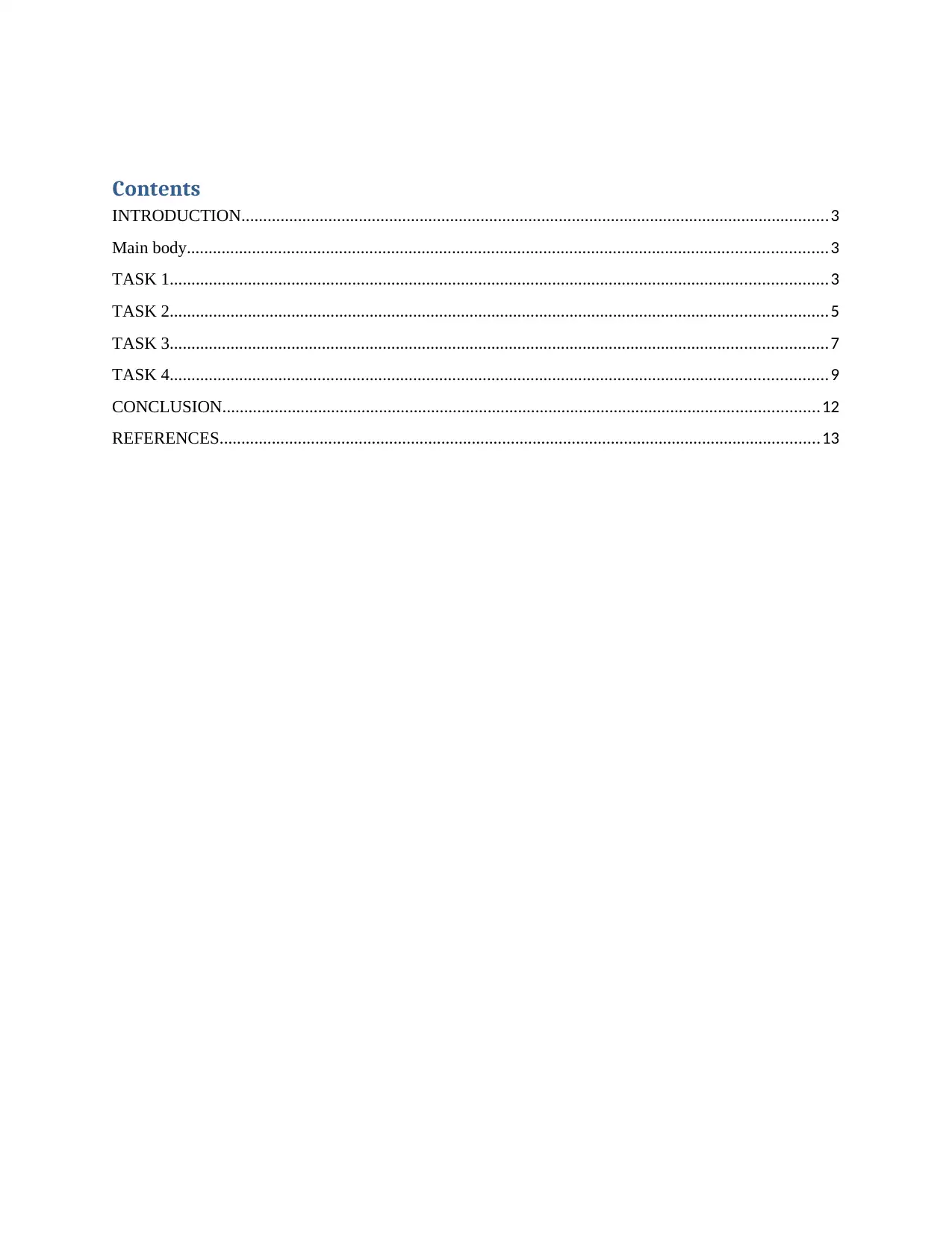
Contents
INTRODUCTION.......................................................................................................................................3
Main body...................................................................................................................................................3
TASK 1.......................................................................................................................................................3
TASK 2.......................................................................................................................................................5
TASK 3.......................................................................................................................................................7
TASK 4.......................................................................................................................................................9
CONCLUSION.........................................................................................................................................12
REFERENCES..........................................................................................................................................13
INTRODUCTION.......................................................................................................................................3
Main body...................................................................................................................................................3
TASK 1.......................................................................................................................................................3
TASK 2.......................................................................................................................................................5
TASK 3.......................................................................................................................................................7
TASK 4.......................................................................................................................................................9
CONCLUSION.........................................................................................................................................12
REFERENCES..........................................................................................................................................13
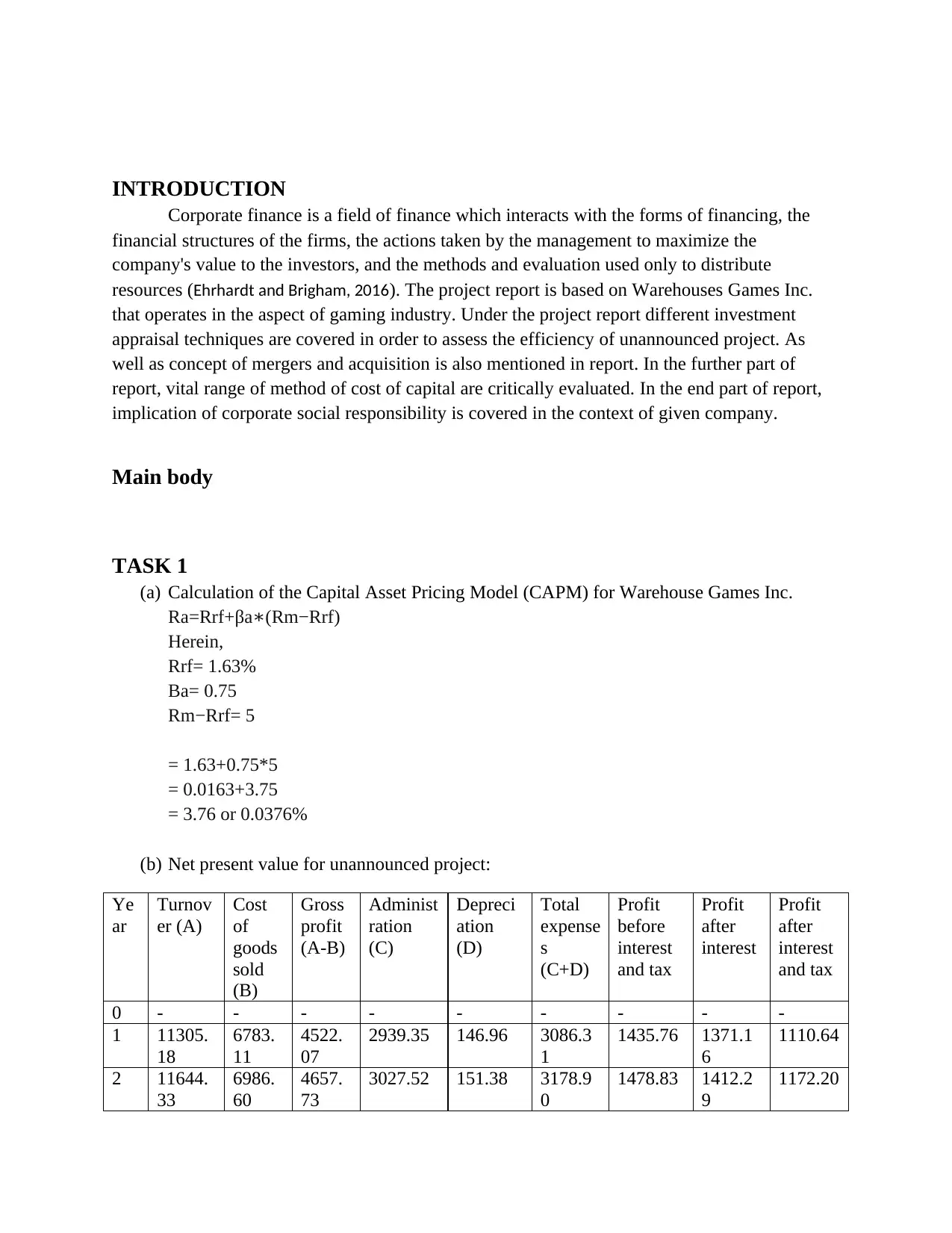
INTRODUCTION
Corporate finance is a field of finance which interacts with the forms of financing, the
financial structures of the firms, the actions taken by the management to maximize the
company's value to the investors, and the methods and evaluation used only to distribute
resources (Ehrhardt and Brigham, 2016). The project report is based on Warehouses Games Inc.
that operates in the aspect of gaming industry. Under the project report different investment
appraisal techniques are covered in order to assess the efficiency of unannounced project. As
well as concept of mergers and acquisition is also mentioned in report. In the further part of
report, vital range of method of cost of capital are critically evaluated. In the end part of report,
implication of corporate social responsibility is covered in the context of given company.
Main body
TASK 1
(a) Calculation of the Capital Asset Pricing Model (CAPM) for Warehouse Games Inc.
Ra=Rrf+βa∗(Rm−Rrf)
Herein,
Rrf= 1.63%
Βa= 0.75
Rm−Rrf= 5
= 1.63+0.75*5
= 0.0163+3.75
= 3.76 or 0.0376%
(b) Net present value for unannounced project:
Ye
ar
Turnov
er (A)
Cost
of
goods
sold
(B)
Gross
profit
(A-B)
Administ
ration
(C)
Depreci
ation
(D)
Total
expense
s
(C+D)
Profit
before
interest
and tax
Profit
after
interest
Profit
after
interest
and tax
0 - - - - - - - - -
1 11305.
18
6783.
11
4522.
07
2939.35 146.96 3086.3
1
1435.76 1371.1
6
1110.64
2 11644.
33
6986.
60
4657.
73
3027.52 151.38 3178.9
0
1478.83 1412.2
9
1172.20
Corporate finance is a field of finance which interacts with the forms of financing, the
financial structures of the firms, the actions taken by the management to maximize the
company's value to the investors, and the methods and evaluation used only to distribute
resources (Ehrhardt and Brigham, 2016). The project report is based on Warehouses Games Inc.
that operates in the aspect of gaming industry. Under the project report different investment
appraisal techniques are covered in order to assess the efficiency of unannounced project. As
well as concept of mergers and acquisition is also mentioned in report. In the further part of
report, vital range of method of cost of capital are critically evaluated. In the end part of report,
implication of corporate social responsibility is covered in the context of given company.
Main body
TASK 1
(a) Calculation of the Capital Asset Pricing Model (CAPM) for Warehouse Games Inc.
Ra=Rrf+βa∗(Rm−Rrf)
Herein,
Rrf= 1.63%
Βa= 0.75
Rm−Rrf= 5
= 1.63+0.75*5
= 0.0163+3.75
= 3.76 or 0.0376%
(b) Net present value for unannounced project:
Ye
ar
Turnov
er (A)
Cost
of
goods
sold
(B)
Gross
profit
(A-B)
Administ
ration
(C)
Depreci
ation
(D)
Total
expense
s
(C+D)
Profit
before
interest
and tax
Profit
after
interest
Profit
after
interest
and tax
0 - - - - - - - - -
1 11305.
18
6783.
11
4522.
07
2939.35 146.96 3086.3
1
1435.76 1371.1
6
1110.64
2 11644.
33
6986.
60
4657.
73
3027.52 151.38 3178.9
0
1478.83 1412.2
9
1172.20
⊘ This is a preview!⊘
Do you want full access?
Subscribe today to unlock all pages.

Trusted by 1+ million students worldwide
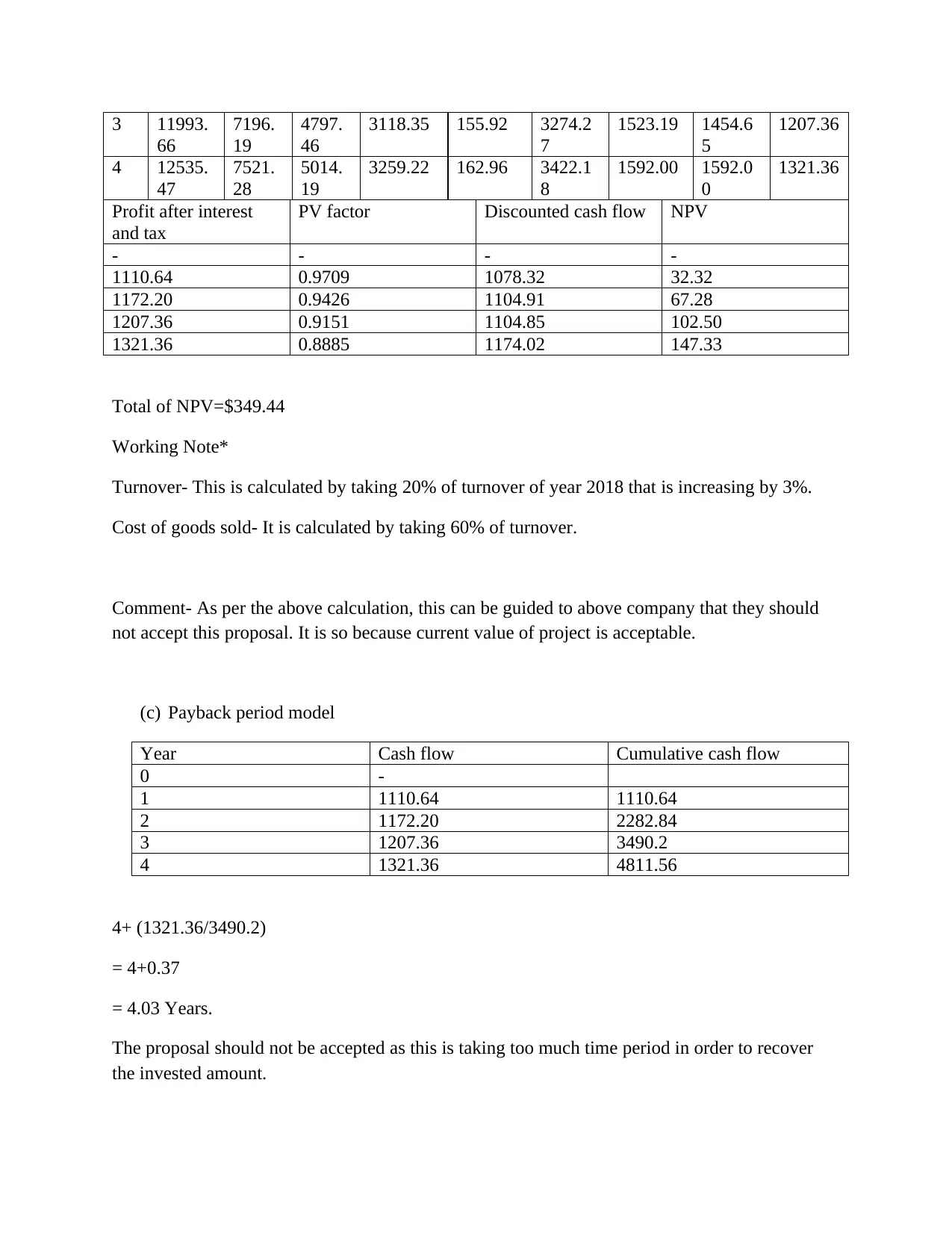
3 11993.
66
7196.
19
4797.
46
3118.35 155.92 3274.2
7
1523.19 1454.6
5
1207.36
4 12535.
47
7521.
28
5014.
19
3259.22 162.96 3422.1
8
1592.00 1592.0
0
1321.36
Profit after interest
and tax
PV factor Discounted cash flow NPV
- - - -
1110.64 0.9709 1078.32 32.32
1172.20 0.9426 1104.91 67.28
1207.36 0.9151 1104.85 102.50
1321.36 0.8885 1174.02 147.33
Total of NPV=$349.44
Working Note*
Turnover- This is calculated by taking 20% of turnover of year 2018 that is increasing by 3%.
Cost of goods sold- It is calculated by taking 60% of turnover.
Comment- As per the above calculation, this can be guided to above company that they should
not accept this proposal. It is so because current value of project is acceptable.
(c) Payback period model
Year Cash flow Cumulative cash flow
0 -
1 1110.64 1110.64
2 1172.20 2282.84
3 1207.36 3490.2
4 1321.36 4811.56
4+ (1321.36/3490.2)
= 4+0.37
= 4.03 Years.
The proposal should not be accepted as this is taking too much time period in order to recover
the invested amount.
66
7196.
19
4797.
46
3118.35 155.92 3274.2
7
1523.19 1454.6
5
1207.36
4 12535.
47
7521.
28
5014.
19
3259.22 162.96 3422.1
8
1592.00 1592.0
0
1321.36
Profit after interest
and tax
PV factor Discounted cash flow NPV
- - - -
1110.64 0.9709 1078.32 32.32
1172.20 0.9426 1104.91 67.28
1207.36 0.9151 1104.85 102.50
1321.36 0.8885 1174.02 147.33
Total of NPV=$349.44
Working Note*
Turnover- This is calculated by taking 20% of turnover of year 2018 that is increasing by 3%.
Cost of goods sold- It is calculated by taking 60% of turnover.
Comment- As per the above calculation, this can be guided to above company that they should
not accept this proposal. It is so because current value of project is acceptable.
(c) Payback period model
Year Cash flow Cumulative cash flow
0 -
1 1110.64 1110.64
2 1172.20 2282.84
3 1207.36 3490.2
4 1321.36 4811.56
4+ (1321.36/3490.2)
= 4+0.37
= 4.03 Years.
The proposal should not be accepted as this is taking too much time period in order to recover
the invested amount.
Paraphrase This Document
Need a fresh take? Get an instant paraphrase of this document with our AI Paraphraser

(d) Evaluation of NPV and payback period method:
NPV model- Throughout accounting, the net present value (NPV) or net present value
(NPW) relates to a range of cash flows arising at various times (Ferran and Ho, 2014). This relies
on the discount rate, too. NPV is liable for the value of money. It offers a tool for measuring and
evaluating capital projects or financial instruments with cash flows accumulated over time, such
as mortgages, deposits, binding arbitration clauses and many other purposes. Such as in the
aspect of above Warehouses Games Inc, this model is being used in order to compute current
value of their project.
Advantages- The advantage of the Net Current Value Approach is that it takes into account the
fundamental idea that perhaps the potential dollar is valued less than a dollar today. As well as
The NPV approach takes into account the cost of capital and the uncertainty involved in making
financial predictions.
Disadvantage- The biggest disadvantage to the net present value approach is that it needs certain
conjecture on the company's operating cost. In fact, the NPV approach is not useful for
contrasting two proposals of various sizes. Because the NPV approach consists in a dollar
answer, the value of the net present value performance is mostly calculated by size of the inputs.
Payback period model- The payback period is the time needed to recover the amount of
money invested in the resource from its net cash flows (Ziegler, 2012). An investment with a
longer payback period is perceived to be good, as when the initial investment of the shareholder
is at stake for a shorter time. In the Warehouses Games Inc this model is used for assessing time
period in order to recover the invested amount.
Advantages- The most major advantage of the payment method is its usability. It is a simple way
of comparing many projects and instead takes a project with the quickest payback period.
Disadvantages- The most significant drawback of the payment method is that it does not take the
value of money into account. The cash flows earned during the earlier years of the venture have a
greater weight than those of the cash flows earned in the years to come.
TASK 2
Discuss the possible outcomes of mergers and acquisitions in the context of the proposed
expansion and the potential effect this would have on its capital structure.
Merger- A merger is a consolidation of two organizations into one, either by removing the
existing entities with one new entity or by incorporating the other.
NPV model- Throughout accounting, the net present value (NPV) or net present value
(NPW) relates to a range of cash flows arising at various times (Ferran and Ho, 2014). This relies
on the discount rate, too. NPV is liable for the value of money. It offers a tool for measuring and
evaluating capital projects or financial instruments with cash flows accumulated over time, such
as mortgages, deposits, binding arbitration clauses and many other purposes. Such as in the
aspect of above Warehouses Games Inc, this model is being used in order to compute current
value of their project.
Advantages- The advantage of the Net Current Value Approach is that it takes into account the
fundamental idea that perhaps the potential dollar is valued less than a dollar today. As well as
The NPV approach takes into account the cost of capital and the uncertainty involved in making
financial predictions.
Disadvantage- The biggest disadvantage to the net present value approach is that it needs certain
conjecture on the company's operating cost. In fact, the NPV approach is not useful for
contrasting two proposals of various sizes. Because the NPV approach consists in a dollar
answer, the value of the net present value performance is mostly calculated by size of the inputs.
Payback period model- The payback period is the time needed to recover the amount of
money invested in the resource from its net cash flows (Ziegler, 2012). An investment with a
longer payback period is perceived to be good, as when the initial investment of the shareholder
is at stake for a shorter time. In the Warehouses Games Inc this model is used for assessing time
period in order to recover the invested amount.
Advantages- The most major advantage of the payment method is its usability. It is a simple way
of comparing many projects and instead takes a project with the quickest payback period.
Disadvantages- The most significant drawback of the payment method is that it does not take the
value of money into account. The cash flows earned during the earlier years of the venture have a
greater weight than those of the cash flows earned in the years to come.
TASK 2
Discuss the possible outcomes of mergers and acquisitions in the context of the proposed
expansion and the potential effect this would have on its capital structure.
Merger- A merger is a consolidation of two organizations into one, either by removing the
existing entities with one new entity or by incorporating the other.
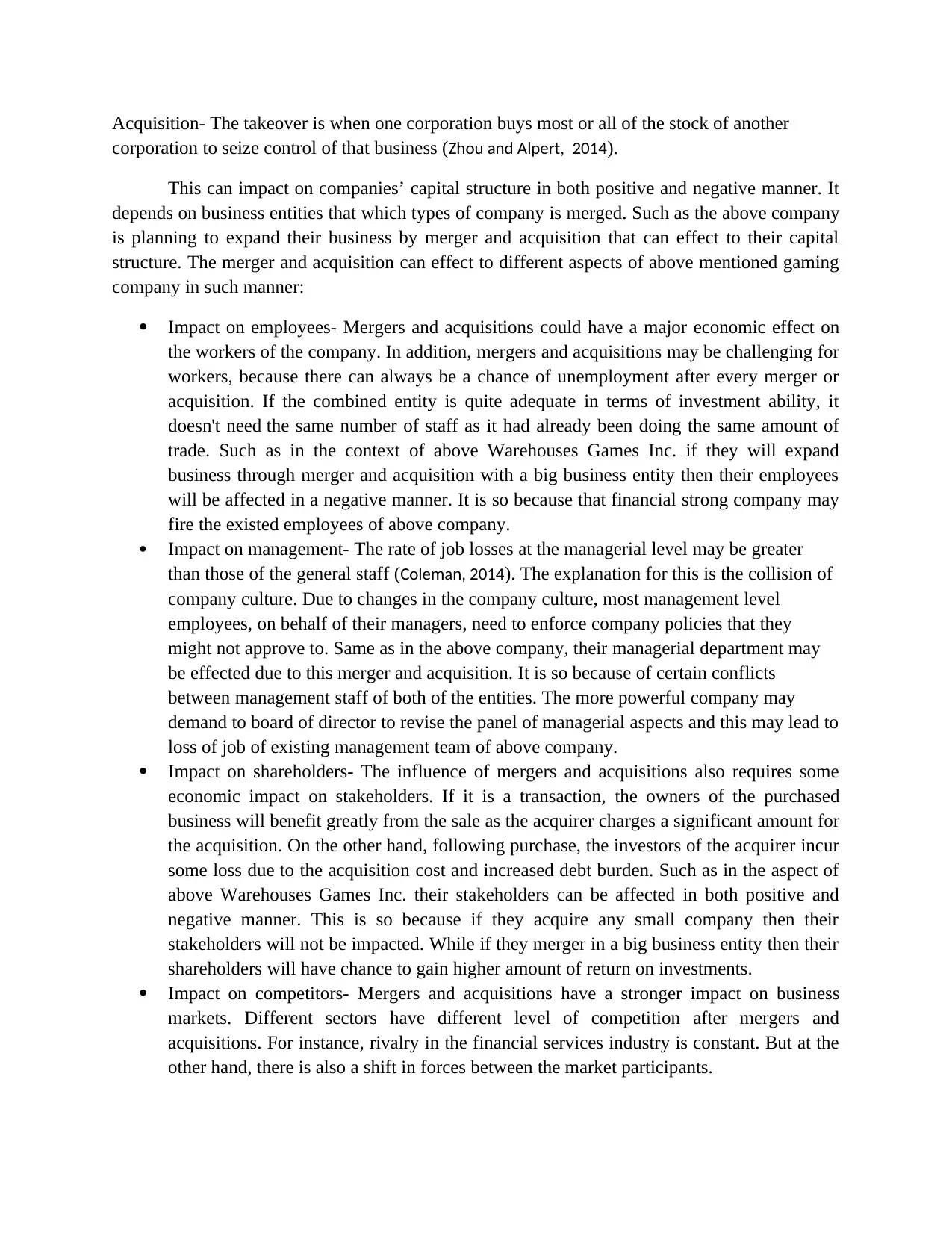
Acquisition- The takeover is when one corporation buys most or all of the stock of another
corporation to seize control of that business (Zhou and Alpert, 2014).
This can impact on companies’ capital structure in both positive and negative manner. It
depends on business entities that which types of company is merged. Such as the above company
is planning to expand their business by merger and acquisition that can effect to their capital
structure. The merger and acquisition can effect to different aspects of above mentioned gaming
company in such manner:
Impact on employees- Mergers and acquisitions could have a major economic effect on
the workers of the company. In addition, mergers and acquisitions may be challenging for
workers, because there can always be a chance of unemployment after every merger or
acquisition. If the combined entity is quite adequate in terms of investment ability, it
doesn't need the same number of staff as it had already been doing the same amount of
trade. Such as in the context of above Warehouses Games Inc. if they will expand
business through merger and acquisition with a big business entity then their employees
will be affected in a negative manner. It is so because that financial strong company may
fire the existed employees of above company.
Impact on management- The rate of job losses at the managerial level may be greater
than those of the general staff (Coleman, 2014). The explanation for this is the collision of
company culture. Due to changes in the company culture, most management level
employees, on behalf of their managers, need to enforce company policies that they
might not approve to. Same as in the above company, their managerial department may
be effected due to this merger and acquisition. It is so because of certain conflicts
between management staff of both of the entities. The more powerful company may
demand to board of director to revise the panel of managerial aspects and this may lead to
loss of job of existing management team of above company.
Impact on shareholders- The influence of mergers and acquisitions also requires some
economic impact on stakeholders. If it is a transaction, the owners of the purchased
business will benefit greatly from the sale as the acquirer charges a significant amount for
the acquisition. On the other hand, following purchase, the investors of the acquirer incur
some loss due to the acquisition cost and increased debt burden. Such as in the aspect of
above Warehouses Games Inc. their stakeholders can be affected in both positive and
negative manner. This is so because if they acquire any small company then their
stakeholders will not be impacted. While if they merger in a big business entity then their
shareholders will have chance to gain higher amount of return on investments.
Impact on competitors- Mergers and acquisitions have a stronger impact on business
markets. Different sectors have different level of competition after mergers and
acquisitions. For instance, rivalry in the financial services industry is constant. But at the
other hand, there is also a shift in forces between the market participants.
corporation to seize control of that business (Zhou and Alpert, 2014).
This can impact on companies’ capital structure in both positive and negative manner. It
depends on business entities that which types of company is merged. Such as the above company
is planning to expand their business by merger and acquisition that can effect to their capital
structure. The merger and acquisition can effect to different aspects of above mentioned gaming
company in such manner:
Impact on employees- Mergers and acquisitions could have a major economic effect on
the workers of the company. In addition, mergers and acquisitions may be challenging for
workers, because there can always be a chance of unemployment after every merger or
acquisition. If the combined entity is quite adequate in terms of investment ability, it
doesn't need the same number of staff as it had already been doing the same amount of
trade. Such as in the context of above Warehouses Games Inc. if they will expand
business through merger and acquisition with a big business entity then their employees
will be affected in a negative manner. It is so because that financial strong company may
fire the existed employees of above company.
Impact on management- The rate of job losses at the managerial level may be greater
than those of the general staff (Coleman, 2014). The explanation for this is the collision of
company culture. Due to changes in the company culture, most management level
employees, on behalf of their managers, need to enforce company policies that they
might not approve to. Same as in the above company, their managerial department may
be effected due to this merger and acquisition. It is so because of certain conflicts
between management staff of both of the entities. The more powerful company may
demand to board of director to revise the panel of managerial aspects and this may lead to
loss of job of existing management team of above company.
Impact on shareholders- The influence of mergers and acquisitions also requires some
economic impact on stakeholders. If it is a transaction, the owners of the purchased
business will benefit greatly from the sale as the acquirer charges a significant amount for
the acquisition. On the other hand, following purchase, the investors of the acquirer incur
some loss due to the acquisition cost and increased debt burden. Such as in the aspect of
above Warehouses Games Inc. their stakeholders can be affected in both positive and
negative manner. This is so because if they acquire any small company then their
stakeholders will not be impacted. While if they merger in a big business entity then their
shareholders will have chance to gain higher amount of return on investments.
Impact on competitors- Mergers and acquisitions have a stronger impact on business
markets. Different sectors have different level of competition after mergers and
acquisitions. For instance, rivalry in the financial services industry is constant. But at the
other hand, there is also a shift in forces between the market participants.
⊘ This is a preview!⊘
Do you want full access?
Subscribe today to unlock all pages.

Trusted by 1+ million students worldwide
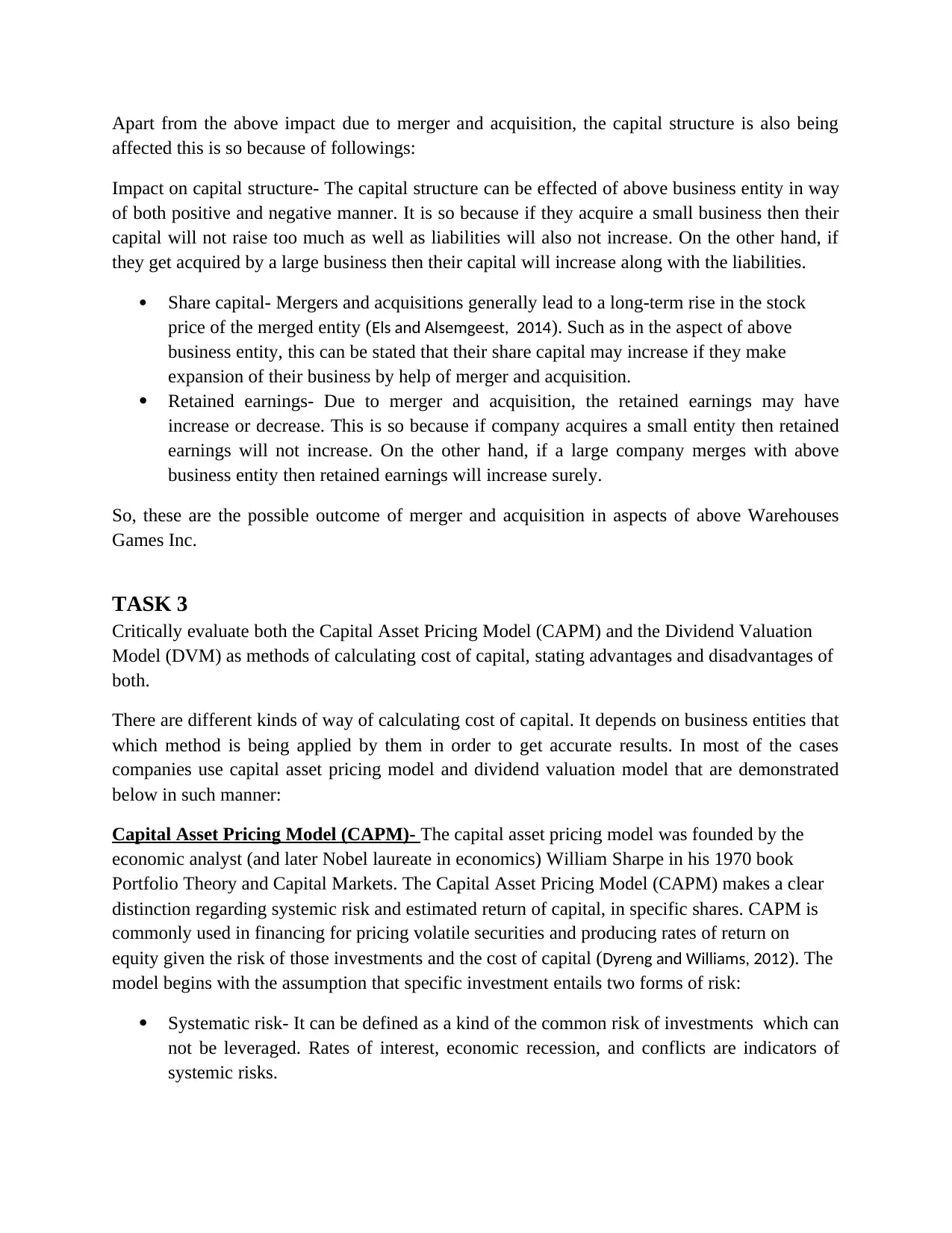
Apart from the above impact due to merger and acquisition, the capital structure is also being
affected this is so because of followings:
Impact on capital structure- The capital structure can be effected of above business entity in way
of both positive and negative manner. It is so because if they acquire a small business then their
capital will not raise too much as well as liabilities will also not increase. On the other hand, if
they get acquired by a large business then their capital will increase along with the liabilities.
Share capital- Mergers and acquisitions generally lead to a long-term rise in the stock
price of the merged entity (Els and Alsemgeest, 2014). Such as in the aspect of above
business entity, this can be stated that their share capital may increase if they make
expansion of their business by help of merger and acquisition.
Retained earnings- Due to merger and acquisition, the retained earnings may have
increase or decrease. This is so because if company acquires a small entity then retained
earnings will not increase. On the other hand, if a large company merges with above
business entity then retained earnings will increase surely.
So, these are the possible outcome of merger and acquisition in aspects of above Warehouses
Games Inc.
TASK 3
Critically evaluate both the Capital Asset Pricing Model (CAPM) and the Dividend Valuation
Model (DVM) as methods of calculating cost of capital, stating advantages and disadvantages of
both.
There are different kinds of way of calculating cost of capital. It depends on business entities that
which method is being applied by them in order to get accurate results. In most of the cases
companies use capital asset pricing model and dividend valuation model that are demonstrated
below in such manner:
Capital Asset Pricing Model (CAPM)- The capital asset pricing model was founded by the
economic analyst (and later Nobel laureate in economics) William Sharpe in his 1970 book
Portfolio Theory and Capital Markets. The Capital Asset Pricing Model (CAPM) makes a clear
distinction regarding systemic risk and estimated return of capital, in specific shares. CAPM is
commonly used in financing for pricing volatile securities and producing rates of return on
equity given the risk of those investments and the cost of capital (Dyreng and Williams, 2012). The
model begins with the assumption that specific investment entails two forms of risk:
Systematic risk- It can be defined as a kind of the common risk of investments which can
not be leveraged. Rates of interest, economic recession, and conflicts are indicators of
systemic risks.
affected this is so because of followings:
Impact on capital structure- The capital structure can be effected of above business entity in way
of both positive and negative manner. It is so because if they acquire a small business then their
capital will not raise too much as well as liabilities will also not increase. On the other hand, if
they get acquired by a large business then their capital will increase along with the liabilities.
Share capital- Mergers and acquisitions generally lead to a long-term rise in the stock
price of the merged entity (Els and Alsemgeest, 2014). Such as in the aspect of above
business entity, this can be stated that their share capital may increase if they make
expansion of their business by help of merger and acquisition.
Retained earnings- Due to merger and acquisition, the retained earnings may have
increase or decrease. This is so because if company acquires a small entity then retained
earnings will not increase. On the other hand, if a large company merges with above
business entity then retained earnings will increase surely.
So, these are the possible outcome of merger and acquisition in aspects of above Warehouses
Games Inc.
TASK 3
Critically evaluate both the Capital Asset Pricing Model (CAPM) and the Dividend Valuation
Model (DVM) as methods of calculating cost of capital, stating advantages and disadvantages of
both.
There are different kinds of way of calculating cost of capital. It depends on business entities that
which method is being applied by them in order to get accurate results. In most of the cases
companies use capital asset pricing model and dividend valuation model that are demonstrated
below in such manner:
Capital Asset Pricing Model (CAPM)- The capital asset pricing model was founded by the
economic analyst (and later Nobel laureate in economics) William Sharpe in his 1970 book
Portfolio Theory and Capital Markets. The Capital Asset Pricing Model (CAPM) makes a clear
distinction regarding systemic risk and estimated return of capital, in specific shares. CAPM is
commonly used in financing for pricing volatile securities and producing rates of return on
equity given the risk of those investments and the cost of capital (Dyreng and Williams, 2012). The
model begins with the assumption that specific investment entails two forms of risk:
Systematic risk- It can be defined as a kind of the common risk of investments which can
not be leveraged. Rates of interest, economic recession, and conflicts are indicators of
systemic risks.
Paraphrase This Document
Need a fresh take? Get an instant paraphrase of this document with our AI Paraphraser
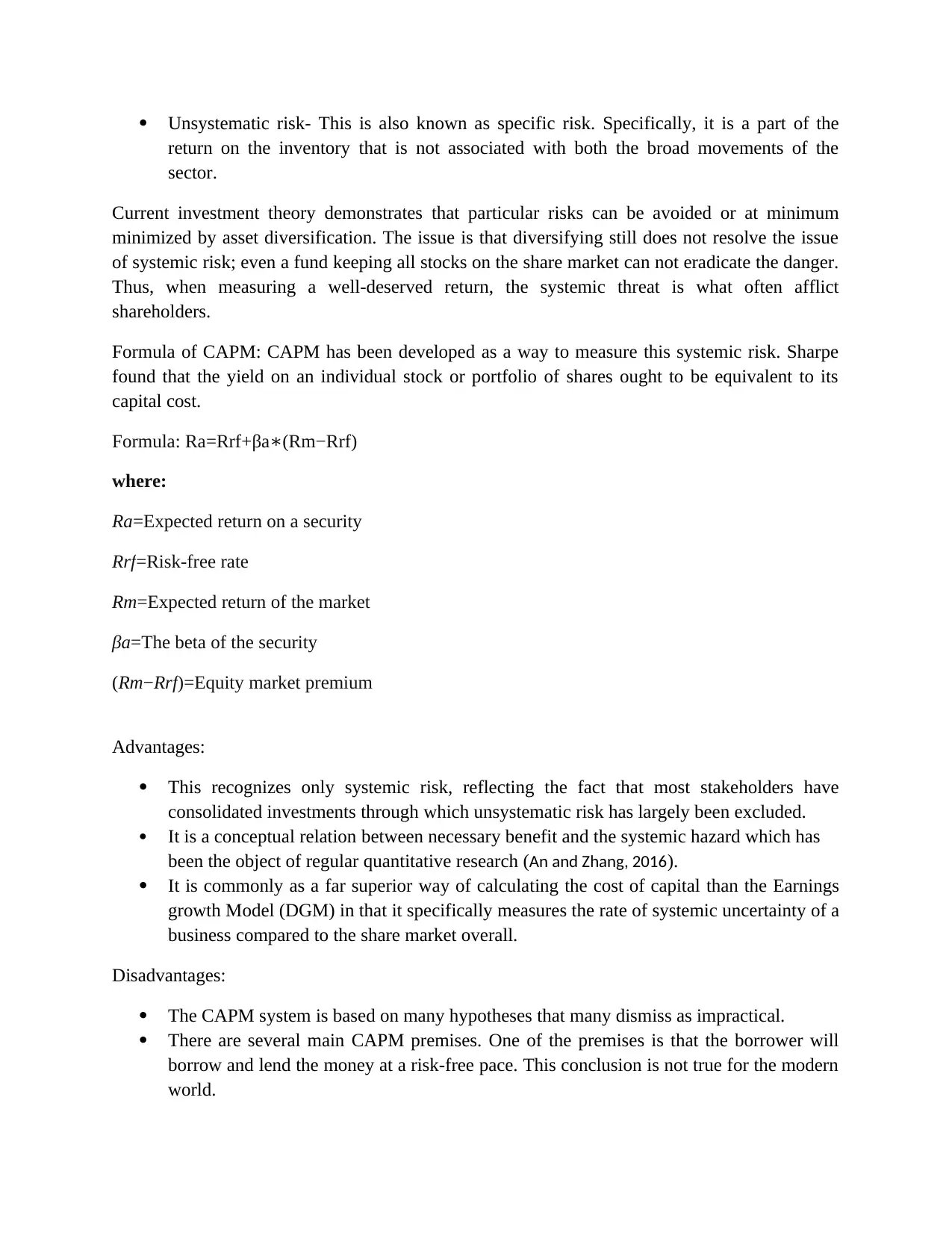
Unsystematic risk- This is also known as specific risk. Specifically, it is a part of the
return on the inventory that is not associated with both the broad movements of the
sector.
Current investment theory demonstrates that particular risks can be avoided or at minimum
minimized by asset diversification. The issue is that diversifying still does not resolve the issue
of systemic risk; even a fund keeping all stocks on the share market can not eradicate the danger.
Thus, when measuring a well-deserved return, the systemic threat is what often afflict
shareholders.
Formula of CAPM: CAPM has been developed as a way to measure this systemic risk. Sharpe
found that the yield on an individual stock or portfolio of shares ought to be equivalent to its
capital cost.
Formula: Ra=Rrf+βa∗(Rm−Rrf)
where:
Ra=Expected return on a security
Rrf=Risk-free rate
Rm=Expected return of the market
βa=The beta of the security
(Rm−Rrf)=Equity market premium
Advantages:
This recognizes only systemic risk, reflecting the fact that most stakeholders have
consolidated investments through which unsystematic risk has largely been excluded.
It is a conceptual relation between necessary benefit and the systemic hazard which has
been the object of regular quantitative research (An and Zhang, 2016).
It is commonly as a far superior way of calculating the cost of capital than the Earnings
growth Model (DGM) in that it specifically measures the rate of systemic uncertainty of a
business compared to the share market overall.
Disadvantages:
The CAPM system is based on many hypotheses that many dismiss as impractical.
There are several main CAPM premises. One of the premises is that the borrower will
borrow and lend the money at a risk-free pace. This conclusion is not true for the modern
world.
return on the inventory that is not associated with both the broad movements of the
sector.
Current investment theory demonstrates that particular risks can be avoided or at minimum
minimized by asset diversification. The issue is that diversifying still does not resolve the issue
of systemic risk; even a fund keeping all stocks on the share market can not eradicate the danger.
Thus, when measuring a well-deserved return, the systemic threat is what often afflict
shareholders.
Formula of CAPM: CAPM has been developed as a way to measure this systemic risk. Sharpe
found that the yield on an individual stock or portfolio of shares ought to be equivalent to its
capital cost.
Formula: Ra=Rrf+βa∗(Rm−Rrf)
where:
Ra=Expected return on a security
Rrf=Risk-free rate
Rm=Expected return of the market
βa=The beta of the security
(Rm−Rrf)=Equity market premium
Advantages:
This recognizes only systemic risk, reflecting the fact that most stakeholders have
consolidated investments through which unsystematic risk has largely been excluded.
It is a conceptual relation between necessary benefit and the systemic hazard which has
been the object of regular quantitative research (An and Zhang, 2016).
It is commonly as a far superior way of calculating the cost of capital than the Earnings
growth Model (DGM) in that it specifically measures the rate of systemic uncertainty of a
business compared to the share market overall.
Disadvantages:
The CAPM system is based on many hypotheses that many dismiss as impractical.
There are several main CAPM premises. One of the premises is that the borrower will
borrow and lend the money at a risk-free pace. This conclusion is not true for the modern
world.
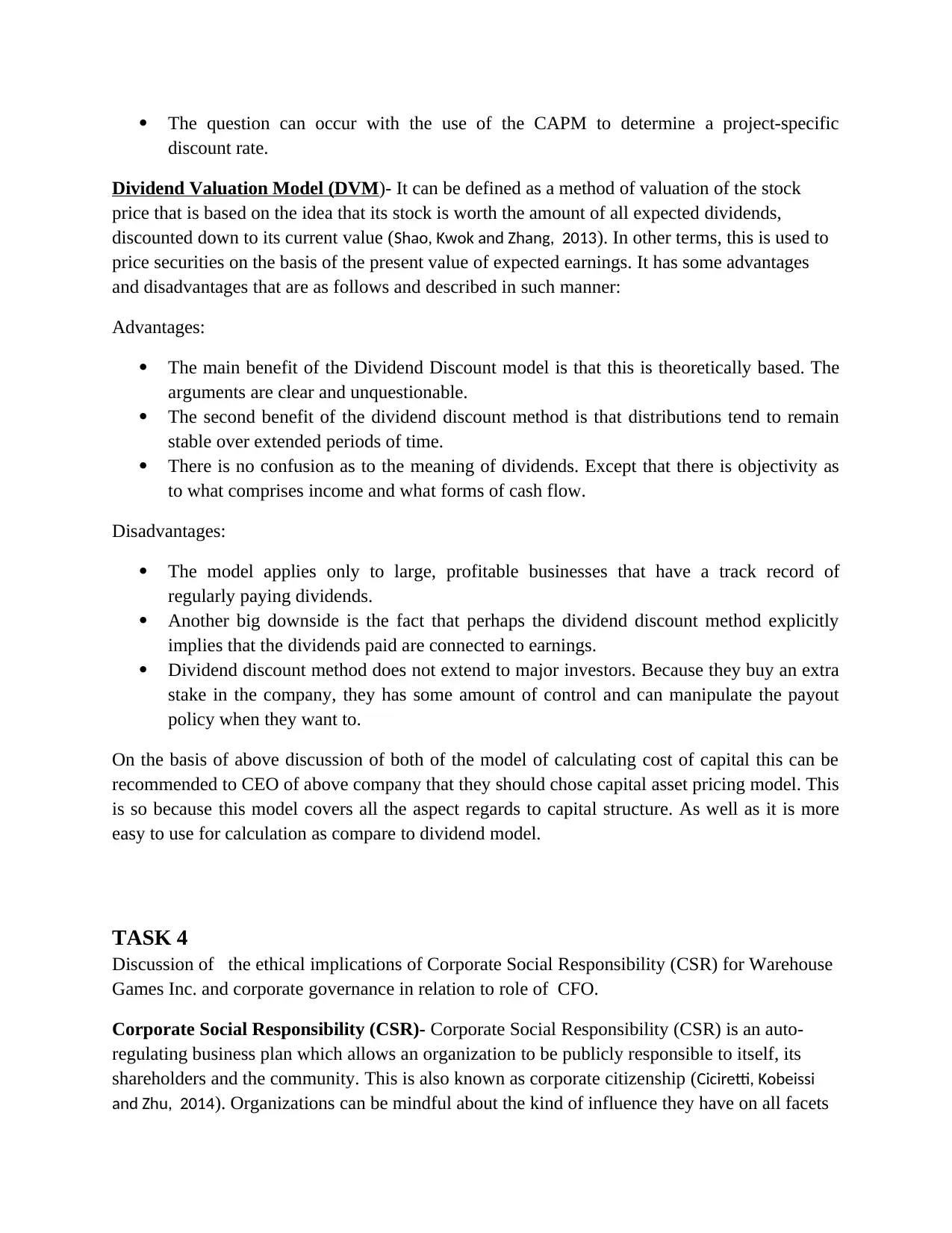
The question can occur with the use of the CAPM to determine a project-specific
discount rate.
Dividend Valuation Model (DVM)- It can be defined as a method of valuation of the stock
price that is based on the idea that its stock is worth the amount of all expected dividends,
discounted down to its current value (Shao, Kwok and Zhang, 2013). In other terms, this is used to
price securities on the basis of the present value of expected earnings. It has some advantages
and disadvantages that are as follows and described in such manner:
Advantages:
The main benefit of the Dividend Discount model is that this is theoretically based. The
arguments are clear and unquestionable.
The second benefit of the dividend discount method is that distributions tend to remain
stable over extended periods of time.
There is no confusion as to the meaning of dividends. Except that there is objectivity as
to what comprises income and what forms of cash flow.
Disadvantages:
The model applies only to large, profitable businesses that have a track record of
regularly paying dividends.
Another big downside is the fact that perhaps the dividend discount method explicitly
implies that the dividends paid are connected to earnings.
Dividend discount method does not extend to major investors. Because they buy an extra
stake in the company, they has some amount of control and can manipulate the payout
policy when they want to.
On the basis of above discussion of both of the model of calculating cost of capital this can be
recommended to CEO of above company that they should chose capital asset pricing model. This
is so because this model covers all the aspect regards to capital structure. As well as it is more
easy to use for calculation as compare to dividend model.
TASK 4
Discussion of the ethical implications of Corporate Social Responsibility (CSR) for Warehouse
Games Inc. and corporate governance in relation to role of CFO.
Corporate Social Responsibility (CSR)- Corporate Social Responsibility (CSR) is an auto-
regulating business plan which allows an organization to be publicly responsible to itself, its
shareholders and the community. This is also known as corporate citizenship (Ciciretti, Kobeissi
and Zhu, 2014). Organizations can be mindful about the kind of influence they have on all facets
discount rate.
Dividend Valuation Model (DVM)- It can be defined as a method of valuation of the stock
price that is based on the idea that its stock is worth the amount of all expected dividends,
discounted down to its current value (Shao, Kwok and Zhang, 2013). In other terms, this is used to
price securities on the basis of the present value of expected earnings. It has some advantages
and disadvantages that are as follows and described in such manner:
Advantages:
The main benefit of the Dividend Discount model is that this is theoretically based. The
arguments are clear and unquestionable.
The second benefit of the dividend discount method is that distributions tend to remain
stable over extended periods of time.
There is no confusion as to the meaning of dividends. Except that there is objectivity as
to what comprises income and what forms of cash flow.
Disadvantages:
The model applies only to large, profitable businesses that have a track record of
regularly paying dividends.
Another big downside is the fact that perhaps the dividend discount method explicitly
implies that the dividends paid are connected to earnings.
Dividend discount method does not extend to major investors. Because they buy an extra
stake in the company, they has some amount of control and can manipulate the payout
policy when they want to.
On the basis of above discussion of both of the model of calculating cost of capital this can be
recommended to CEO of above company that they should chose capital asset pricing model. This
is so because this model covers all the aspect regards to capital structure. As well as it is more
easy to use for calculation as compare to dividend model.
TASK 4
Discussion of the ethical implications of Corporate Social Responsibility (CSR) for Warehouse
Games Inc. and corporate governance in relation to role of CFO.
Corporate Social Responsibility (CSR)- Corporate Social Responsibility (CSR) is an auto-
regulating business plan which allows an organization to be publicly responsible to itself, its
shareholders and the community. This is also known as corporate citizenship (Ciciretti, Kobeissi
and Zhu, 2014). Organizations can be mindful about the kind of influence they have on all facets
⊘ This is a preview!⊘
Do you want full access?
Subscribe today to unlock all pages.

Trusted by 1+ million students worldwide

of society, including the political, environmental and social aspects. In the aspect of above
company of case study, this can be find out that their team of developers are extracting personal
information from customers games files and selling this data to third parties. In this case, it can
be find out that they are not following model of CSR. As a role of chief finance officer, this is
essential to make awareness to all employees to follow ethics of corporate social responsibility.
Eventually, there are four kinds of obligations for business entities that are as followings:
Discretionary obligation- It applies to a voluntary contribution produced by a company
to the betterment of humanity with no government interference.
Ethical obligation- It applies to holding a company responsible for dealing with and
complying with cultural and social standards set down by the people..
Legal obligation- It is the obligation of each company to comply with the regulations of
the jurisdiction and to comply with both the legal regulations set down by the
government.
Economic obligation- Since any enterprise aims to make a gain, it is also the duty of
every company to produce excess cash and use it for the better development of
humanity.
Apart from the above mentioned obligations there are some other responsibilities for a business
entities towards different aspects of environment that are as follows:
Towards customers- This is important for business entities to follow of ethics of doing
business in an effective manner so that they can get full value of money. The business
entities should not conduct any act that harm the rights of customers. In the aspect of
above chosen company Warehouse Games Inc, this is crucial for their developer team
to keep the information of customers secure and safe. They should not extract their
personal information.
Towards public- In order to maintain a strong public image and attracting new
customers, a corporation must recognize its corporate obligations to the community.
Like in the aspect of above Warehouse Games Inc, they should complete their
responsibility towards the society in which they exists. They should not conduct any
kind of act that harms the rights of public. Along with they are needed to develop kinds
of games which are suitable as perspective of society and not against any religion.
Towards government- The simplest way for businesses to demonstrate social
responsibility to the government is to ensure full conformity with laws, which are, in
essence, the main demands of the policy on the part of corporations (Boubakri, Guedhami
and Kwok, 2016). As far as policy is concerned, nothing much could be done but to
provide collaboration to law enforcement agencies. In one way or another, all business
sectors will benefit from the regulations imposed by the government. The economic
environment thrives where corporations find it necessary to run their operations and
avoid possible violations by customers and other investors. In the aspect of above
company of case study, this can be find out that their team of developers are extracting personal
information from customers games files and selling this data to third parties. In this case, it can
be find out that they are not following model of CSR. As a role of chief finance officer, this is
essential to make awareness to all employees to follow ethics of corporate social responsibility.
Eventually, there are four kinds of obligations for business entities that are as followings:
Discretionary obligation- It applies to a voluntary contribution produced by a company
to the betterment of humanity with no government interference.
Ethical obligation- It applies to holding a company responsible for dealing with and
complying with cultural and social standards set down by the people..
Legal obligation- It is the obligation of each company to comply with the regulations of
the jurisdiction and to comply with both the legal regulations set down by the
government.
Economic obligation- Since any enterprise aims to make a gain, it is also the duty of
every company to produce excess cash and use it for the better development of
humanity.
Apart from the above mentioned obligations there are some other responsibilities for a business
entities towards different aspects of environment that are as follows:
Towards customers- This is important for business entities to follow of ethics of doing
business in an effective manner so that they can get full value of money. The business
entities should not conduct any act that harm the rights of customers. In the aspect of
above chosen company Warehouse Games Inc, this is crucial for their developer team
to keep the information of customers secure and safe. They should not extract their
personal information.
Towards public- In order to maintain a strong public image and attracting new
customers, a corporation must recognize its corporate obligations to the community.
Like in the aspect of above Warehouse Games Inc, they should complete their
responsibility towards the society in which they exists. They should not conduct any
kind of act that harms the rights of public. Along with they are needed to develop kinds
of games which are suitable as perspective of society and not against any religion.
Towards government- The simplest way for businesses to demonstrate social
responsibility to the government is to ensure full conformity with laws, which are, in
essence, the main demands of the policy on the part of corporations (Boubakri, Guedhami
and Kwok, 2016). As far as policy is concerned, nothing much could be done but to
provide collaboration to law enforcement agencies. In one way or another, all business
sectors will benefit from the regulations imposed by the government. The economic
environment thrives where corporations find it necessary to run their operations and
avoid possible violations by customers and other investors. In the aspect of above
Paraphrase This Document
Need a fresh take? Get an instant paraphrase of this document with our AI Paraphraser
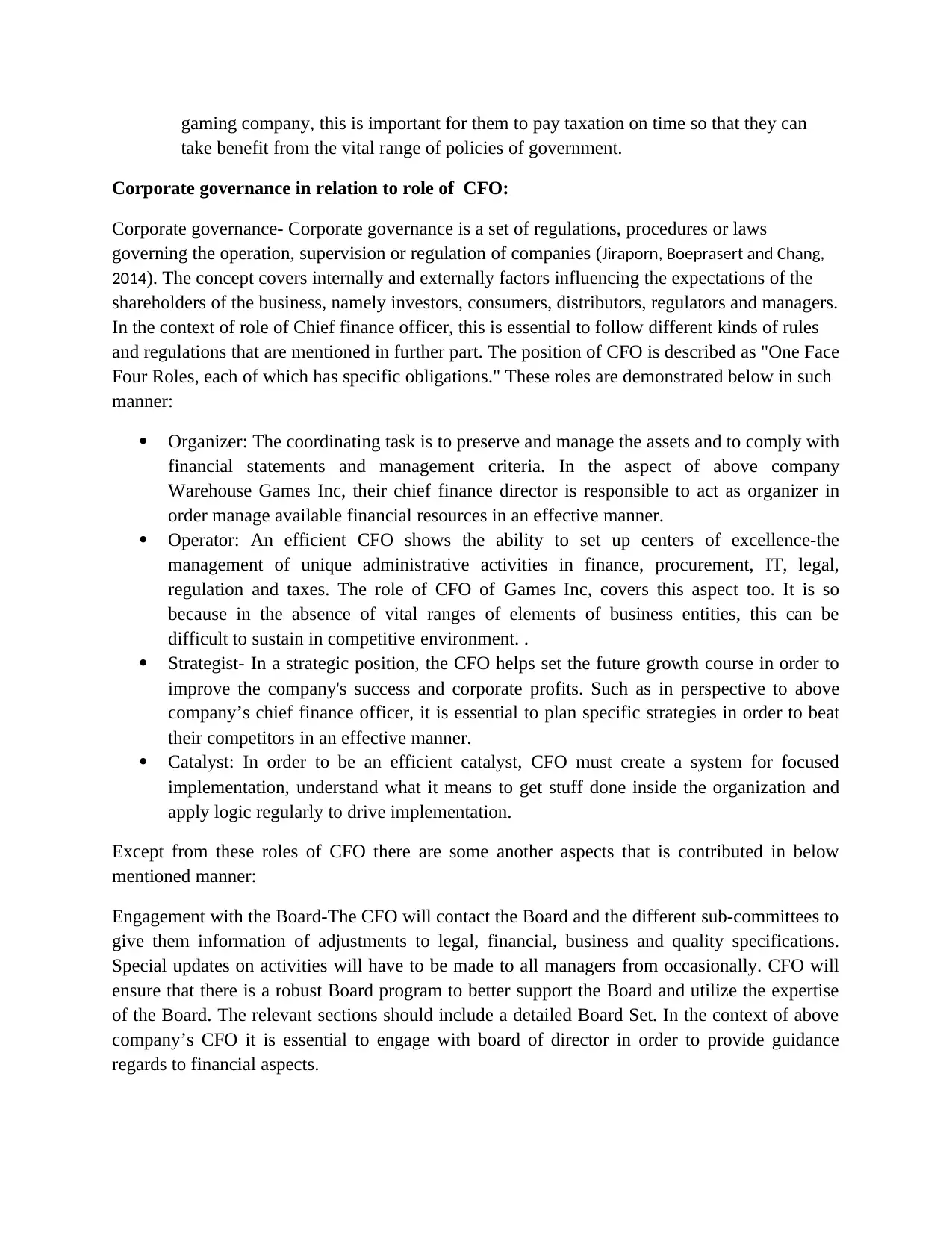
gaming company, this is important for them to pay taxation on time so that they can
take benefit from the vital range of policies of government.
Corporate governance in relation to role of CFO:
Corporate governance- Corporate governance is a set of regulations, procedures or laws
governing the operation, supervision or regulation of companies (Jiraporn, Boeprasert and Chang,
2014). The concept covers internally and externally factors influencing the expectations of the
shareholders of the business, namely investors, consumers, distributors, regulators and managers.
In the context of role of Chief finance officer, this is essential to follow different kinds of rules
and regulations that are mentioned in further part. The position of CFO is described as "One Face
Four Roles, each of which has specific obligations." These roles are demonstrated below in such
manner:
Organizer: The coordinating task is to preserve and manage the assets and to comply with
financial statements and management criteria. In the aspect of above company
Warehouse Games Inc, their chief finance director is responsible to act as organizer in
order manage available financial resources in an effective manner.
Operator: An efficient CFO shows the ability to set up centers of excellence-the
management of unique administrative activities in finance, procurement, IT, legal,
regulation and taxes. The role of CFO of Games Inc, covers this aspect too. It is so
because in the absence of vital ranges of elements of business entities, this can be
difficult to sustain in competitive environment. .
Strategist- In a strategic position, the CFO helps set the future growth course in order to
improve the company's success and corporate profits. Such as in perspective to above
company’s chief finance officer, it is essential to plan specific strategies in order to beat
their competitors in an effective manner.
Catalyst: In order to be an efficient catalyst, CFO must create a system for focused
implementation, understand what it means to get stuff done inside the organization and
apply logic regularly to drive implementation.
Except from these roles of CFO there are some another aspects that is contributed in below
mentioned manner:
Engagement with the Board-The CFO will contact the Board and the different sub-committees to
give them information of adjustments to legal, financial, business and quality specifications.
Special updates on activities will have to be made to all managers from occasionally. CFO will
ensure that there is a robust Board program to better support the Board and utilize the expertise
of the Board. The relevant sections should include a detailed Board Set. In the context of above
company’s CFO it is essential to engage with board of director in order to provide guidance
regards to financial aspects.
take benefit from the vital range of policies of government.
Corporate governance in relation to role of CFO:
Corporate governance- Corporate governance is a set of regulations, procedures or laws
governing the operation, supervision or regulation of companies (Jiraporn, Boeprasert and Chang,
2014). The concept covers internally and externally factors influencing the expectations of the
shareholders of the business, namely investors, consumers, distributors, regulators and managers.
In the context of role of Chief finance officer, this is essential to follow different kinds of rules
and regulations that are mentioned in further part. The position of CFO is described as "One Face
Four Roles, each of which has specific obligations." These roles are demonstrated below in such
manner:
Organizer: The coordinating task is to preserve and manage the assets and to comply with
financial statements and management criteria. In the aspect of above company
Warehouse Games Inc, their chief finance director is responsible to act as organizer in
order manage available financial resources in an effective manner.
Operator: An efficient CFO shows the ability to set up centers of excellence-the
management of unique administrative activities in finance, procurement, IT, legal,
regulation and taxes. The role of CFO of Games Inc, covers this aspect too. It is so
because in the absence of vital ranges of elements of business entities, this can be
difficult to sustain in competitive environment. .
Strategist- In a strategic position, the CFO helps set the future growth course in order to
improve the company's success and corporate profits. Such as in perspective to above
company’s chief finance officer, it is essential to plan specific strategies in order to beat
their competitors in an effective manner.
Catalyst: In order to be an efficient catalyst, CFO must create a system for focused
implementation, understand what it means to get stuff done inside the organization and
apply logic regularly to drive implementation.
Except from these roles of CFO there are some another aspects that is contributed in below
mentioned manner:
Engagement with the Board-The CFO will contact the Board and the different sub-committees to
give them information of adjustments to legal, financial, business and quality specifications.
Special updates on activities will have to be made to all managers from occasionally. CFO will
ensure that there is a robust Board program to better support the Board and utilize the expertise
of the Board. The relevant sections should include a detailed Board Set. In the context of above
company’s CFO it is essential to engage with board of director in order to provide guidance
regards to financial aspects.
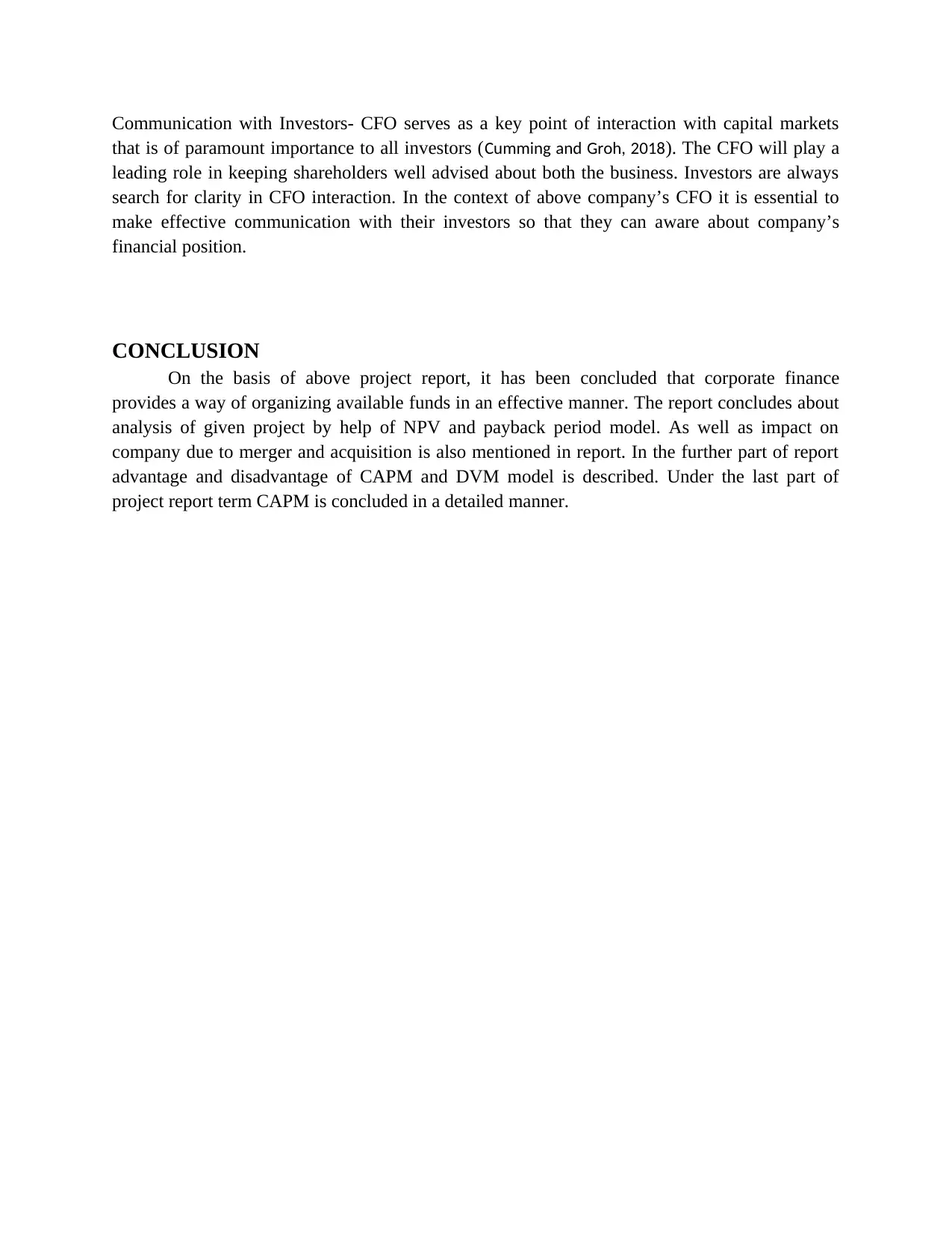
Communication with Investors- CFO serves as a key point of interaction with capital markets
that is of paramount importance to all investors (Cumming and Groh, 2018). The CFO will play a
leading role in keeping shareholders well advised about both the business. Investors are always
search for clarity in CFO interaction. In the context of above company’s CFO it is essential to
make effective communication with their investors so that they can aware about company’s
financial position.
CONCLUSION
On the basis of above project report, it has been concluded that corporate finance
provides a way of organizing available funds in an effective manner. The report concludes about
analysis of given project by help of NPV and payback period model. As well as impact on
company due to merger and acquisition is also mentioned in report. In the further part of report
advantage and disadvantage of CAPM and DVM model is described. Under the last part of
project report term CAPM is concluded in a detailed manner.
that is of paramount importance to all investors (Cumming and Groh, 2018). The CFO will play a
leading role in keeping shareholders well advised about both the business. Investors are always
search for clarity in CFO interaction. In the context of above company’s CFO it is essential to
make effective communication with their investors so that they can aware about company’s
financial position.
CONCLUSION
On the basis of above project report, it has been concluded that corporate finance
provides a way of organizing available funds in an effective manner. The report concludes about
analysis of given project by help of NPV and payback period model. As well as impact on
company due to merger and acquisition is also mentioned in report. In the further part of report
advantage and disadvantage of CAPM and DVM model is described. Under the last part of
project report term CAPM is concluded in a detailed manner.
⊘ This is a preview!⊘
Do you want full access?
Subscribe today to unlock all pages.

Trusted by 1+ million students worldwide
1 out of 14
Related Documents
Your All-in-One AI-Powered Toolkit for Academic Success.
+13062052269
info@desklib.com
Available 24*7 on WhatsApp / Email
![[object Object]](/_next/static/media/star-bottom.7253800d.svg)
Unlock your academic potential
Copyright © 2020–2026 A2Z Services. All Rights Reserved. Developed and managed by ZUCOL.





